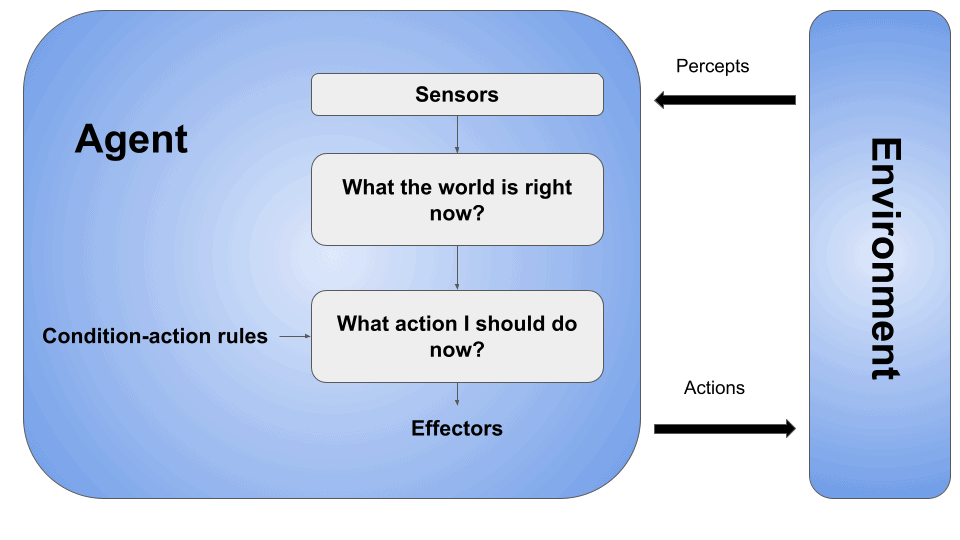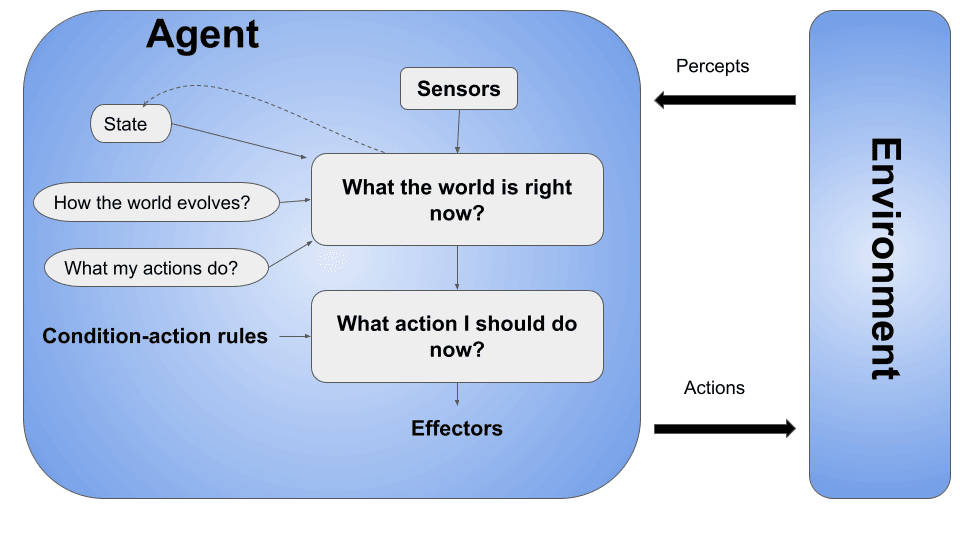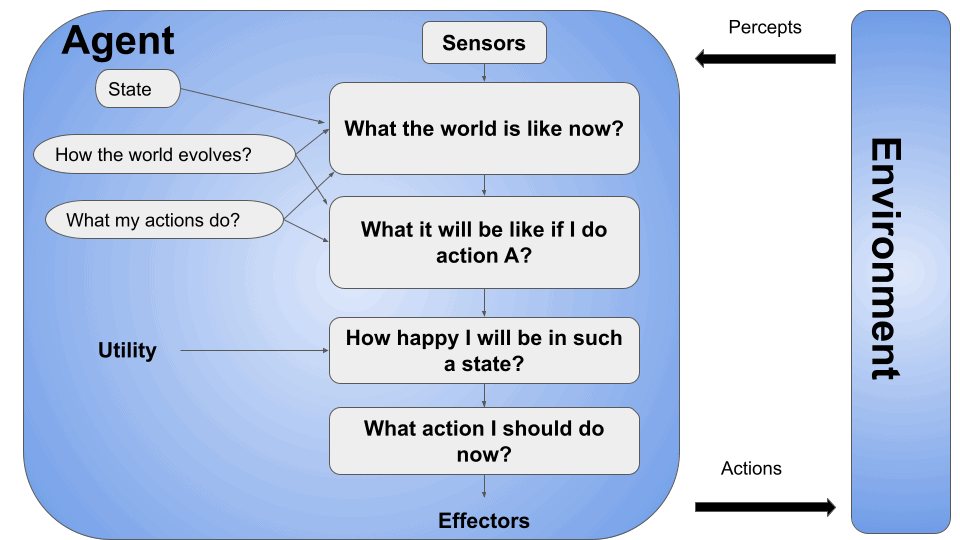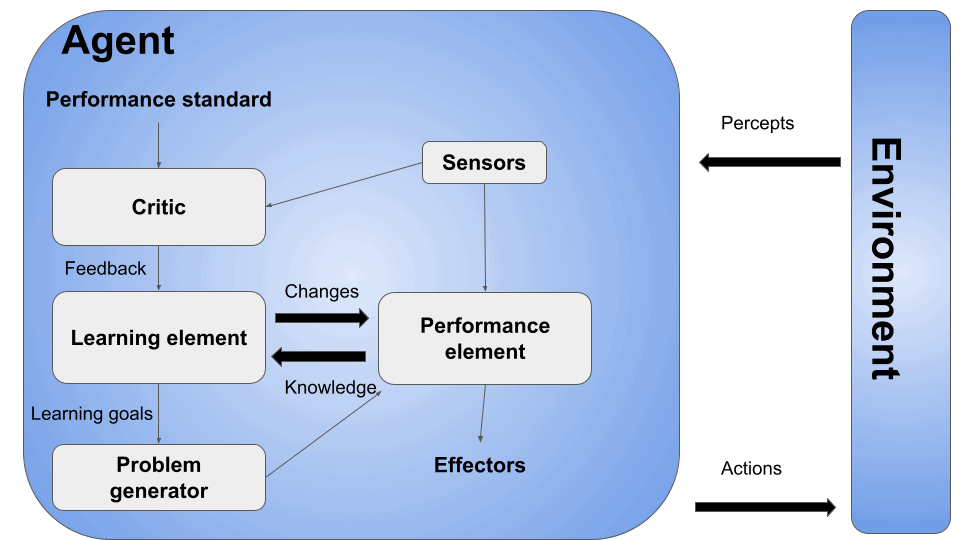1. Overview
Artificial intelligence, the cutting-edge technology that simulates human intelligence in machines, has revolutionized various industries and continues to shape our future. Artificial intelligence agents have evolved significantly over time, from early expert systems in 1970 to the advent of machine learning algorithms and deep neural networks in recent decades.
In this tutorial, we’ll delve into the realm of Artificial Intelligence Agents, exploring their environment, types, and examples.
2. Artificial Intelligence Agents
An artificial intelligence agent can be defined as a program that makes decisions and takes action based on the decisions. These agents are designed to mimic or replicate human intelligence and decision-making capabilities. The critical components of Artificial Intelligence agents include:
2.1. Perception
Artificial Intelligence agents perceive and gather information about their environment through various sensors, such as cameras, microphones, or text input. They can analyze and interpret the data they receive to understand the state of the environment or extract relevant features.
2.2. Reasoning and Decision-Making
Artificial Intelligence agents use reasoning and decision-making algorithms to analyze the available information and determine the best course of action to achieve their goals. They may use techniques like rule-based systems, logical reasoning, machine learning, or reinforcement learning to make decisions and select appropriate actions.
2.3. Action
Artificial Intelligence agents can act in their environment based on their decisions and goals. These actions can range from simple tasks like moving an object in a physical environment to complex interactions in virtual or social environments.
2.4. Learning and Adaptation
Artificial Intelligence agents can learn from their experiences and adapt their behaviour based on the feedback they receive. They can update their knowledge, improve their decision-making capabilities, and adjust their actions to achieve better performance over time.
2.5. Communication and Interaction
Artificial Intelligence agents can communicate and interact with humans or other agents through various modalities, such as speech, text, or gestures. They can understand and generate natural language, engage in conversations, and respond to queries or requests.
3. Artificial Intelligence Agents’ Environments
Artificial Intelligence agents can operate in various environments, depending on their specific tasks and applications. Here are some common types of environments in which Artificial Intelligence agents can operate:
3.1. Virtual Environments
Artificial Intelligence agents can operate in simulated or virtual environments, which are computer-generated environments that mimic real-world scenarios. These environments provide a controlled setting for training and testing Artificial Intelligence agents without the risks or costs associated with physical environments. Let’s now take a look at some examples:
- DeepMind’s AlphaStar: Artificial Intelligence system that achieved Grandmaster-level performance in the real-time strategy game StarCraft II, competing against professional human players
- NVIDIA’s Artificial Intelligence driving simulator: which uses virtual environments to train autonomous vehicles in a variety of driving scenarios
3.2. Physical Environments
Artificial Intelligence agents can also operate in physical environments, which are the real-world spaces where they perform tasks. These environments range from factories and warehouses to homes, hospitals, and outdoor spaces. Artificial Intelligence agents in physical environments often use sensors (such as cameras, lidar, or microphones) to perceive their surroundings and actuators (such as robotic arms or wheels) to interact with the environment.
Here are some examples:
- Homes: artificial Intelligence agents can be integrated into smart homes to assist with tasks such as controlling home appliances, managing energy consumption, providing personalized recommendations, and enhancing home security
- Offices: artificial Intelligence agents can be utilized in office spaces to automate routine administrative tasks, manage schedules, facilitate communication and collaboration, and provide virtual assistance to employees
- Airports: artificial Intelligence agents can be used in airports for tasks like passenger check-in, security screening, wayfinding, baggage handling, and providing real-time flight information to enhance the overall travel experience
3.3. Web and Internet Environments
Artificial Intelligence agents can interact with web-based environments and the internet. Artificial Intelligence agents can browse websites, extract information, analyze data, perform natural language processing, and interact with users through chatbots or virtual assistants. Here are some examples:
- Search engines: Artificial Intelligence agents power searches engines like Google, Bing, and Yahoo, enabling users to find relevant information by analyzing web content, understanding user queries, and providing accurate search results
- Social media platforms: Artificial Intelligence agents operate on social media platforms such as Facebook, Twitter, and Instagram to analyze user data, curate personalized feeds, detect and filter content, and provide ad targeting and recommendations
- Language translation: Artificial Intelligence agents power languages translation services like Google Translate and Microsoft Translator, enabling users to translate text and speech between different languages
3.4. Text-Based Environments
Artificial Intelligence agents can operate in text-based environments, processing and generating natural language text. These environments can involve tasks like language translation, sentiment analysis, text summarization, question-answering, and chat-based interactions. Let’s now take a look at some examples:
- Chatbots: websites and messaging platforms use Artificial Intelligence-powered chatbots to provide instant customer support, answer frequently asked questions, assist with product recommendations, and handle basic inquiries
- Email clients: artificial Intelligence agents can operate in email clients to assist users in organizing and prioritizing emails, suggesting responses, detecting spam or phishing emails, and providing smart email categorization
3.5. Game Environments
Artificial Intelligence agents can be trained and operate in-game environments, ranging from classic board games like chess and Go to complex video games. Game environments provide well-defined rules and objectives, making them suitable for developing Artificial Intelligence algorithms and evaluating agent performance. Here’re some examples:
- Video games: artificial Intelligence agents can be designed to play and compete against human players or other Artificial Intelligence opponents in video games
- Casino games: casino games like poker, blackjack, and roulette utilize Artificial Intelligence agents either as opponents or as virtual dealers, providing realistic and challenging gameplay experiences
- Mobile games: artificial Intelligence agents can be integrated into mobile games across various genres, including puzzle games, strategy games, casual games, and augmented reality games
3.6. Social Environments
Artificial Intelligence agents can be designed to operate in social environments, interacting and collaborating with humans or other agents. Social environments can involve tasks like social chatbots, virtual companions, collaborative robots, and multi-agent systems. Here’re some examples:
- Dating platforms: artificial Intelligence agents can be used in online dating platforms to match users based on their preferences, analyze user profiles and behaviours, and provide recommendations for potential matches
- Social media platforms: artificial Intelligence agents can be used on social media platforms like Facebook, Twitter, and Instagram to analyze user data, curate personalized feeds, detect and filter content and provide ad targeting
4. Types of Artificial Intelligence Agents
Agents are classified into five classes based on their agent programs. Let’s discover those classes.
4.1. Simple Reflex Agents
Simple Reflex (SR) agents make decisions based on the current percept or input without considering the history or future consequences. SR agents operate correctly only in the fully observable environment, here’s the leading architecture of SR agents:

4.2. Model-Based Agents
These agents have internal models or representations of the world, enabling them to consider the history of percepts to make more informed decisions, here’s the main architecture of a model-based agent:

4.3. Goal-Based Agents
These agents have specific goals or objectives they strive to achieve. They use their internal models to plan and take actions that are likely to lead them toward their goals. Here’s the central architecture of the SR agent:

4.4. Utility-based Agents
These agents consider their goals and the desirability or utility of different outcomes. Moreover, They make decisions based on the expected utility of different actions. Here’s the main architecture of a Utility-based agent:

4.5. Learning Agent
These agents can learn from their environment and past experiences. Furthermore, they can adapt and improve their performance over time by updating their internal models or adjusting their decision-making strategies. However, a learning agent has mainly four conceptual components, which are:
- Learning element: it’s responsible for making improvements by learning from the environment
- Critic: the learning element takes feedback from critics, which describes how well the agent is doing concerning a fixed performance standard
- Performance element: it’s responsible for selecting external action
- Problem Generator: this component suggests actions leading to new and informative experiences. Here’s the main architecture of the learning agent:

5. Artificial Intelligence Agents Examples
5.1. Chatbots and Virtual Assistants
Chatbots are Artificial Intelligence agents that interact with humans through text or speech. On the other hand, they can understand natural language inputs and provide relevant responses. here’re some examples:
- Siri: Apple’s virtual assistant that can perform tasks, answer questions, and provide recommendations on iOS devices
- Google Assistant: Google’s virtual assistant available on Android devices and other platforms, provides information, performs tasks, and controls smart devices
- Amazon Alexa: Amazon’s virtual assistant used in devices like Echo, capable of controlling smart home devices, answering questions, and playing music
5.2. Autonomous Vehicles
Self-driving cars and autonomous drones are Artificial Intelligence agents that perceive their environment through sensors such as cameras and lidar, process the data to make decisions, and control their actions accordingly. Here’re some examples:
- Tesla Autopilot: Tesla’s Artificial Intelligence-powered system that enables self-driving capabilities in their electric vehicles
- Waymo: Alphabet’s autonomous vehicle project that focuses on developing self-driving technology and is testing in various locations
5.3. Recommendation Systems
These agents analyze user preferences and behavior to provide personalized recommendations. Examples include the recommendation algorithms used by streaming platforms, here’re some examples:
- Netflix: uses Artificial Intelligence algorithms to analyze user viewing habits and provide personalized movie and TV show recommendations
- Spotify: utilizes Artificial Intelligence to analyze user listening patterns and preferences, offering personalized music recommendations and curated playlists
5.4. Game-Playing Agents
Artificial Intelligence agents have demonstrated remarkable performance in various games, here’re some examples:
- Deep Blue: IBM’s chess-playing Artificial Intelligence that famously defeated world chess champion Garry Kasparov in 1997
- AlphaGo: DeepMind develops AlphaGo, it’s an Artificial Intelligence agent that defeated the world Go champion Lee Sedol in 2016
5.5. Medical Diagnosis
We use Artificial Intelligence agents to assist in medical diagnosis by analyzing patient data, symptoms, and medical records to provide recommendations or predictions for disease identification and treatment. Let’s take a look at some examples:
- IBM Watson For Oncology: Artificial Intelligence agent that assists oncologists in analyzing patient data and medical literature to provide personalized treatment recommendations
- DeepMind’s DeepVariant: we use an artificial intelligence agent to analyze genomic data and identify genetic variations associated with diseases
5.6. Robotics
We use artificial intelligence agents in robotic systems for tasks like object recognition, motion planning, and human-robot interaction. Let’s take a look at some examples:
- Boston Dynamics’ Spot: A robotic dog that uses Artificial Intelligence to navigate and perform tasks like inspection and data collection in various industries
- SoftBank Robotics’ Pepper: A humanoid robot that uses Artificial Intelligence to interact with people, provide information, and assist in various settings
6. Conclusion
In conclusion, we have explored the concept of artificial intelligence agents and their role in various environments. As a result, we design Artificial Intelligence agents are software systems to perform specific tasks or interact with their environment using artificial intelligence techniques.